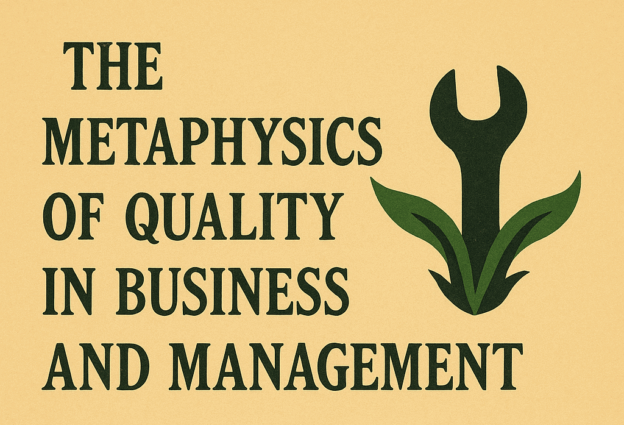Exploring how the principles of quality can be applied in business settings, focusing on customer satisfaction, product development, and ethical management practices.
Robert M. Pirsig’s Metaphysics of Quality (MOQ) presents a unique philosophical framework that places quality at the core of understanding reality and human experience. While initially conceptualized in a broader philosophical context, the principles of quality outlined by Pirsig can be profoundly influential in business settings. By applying these principles, businesses can enhance customer satisfaction, improve product development, and adopt ethical management practices. This article explores how the Metaphysics of Quality can be integrated into various aspects of business and management.
Quality as the Foundation of Business Success
In the Metaphysics of Quality, Pirsig posits that quality is the primary reality, an intrinsic aspect of all experiences. When applied to business, this means that quality should be the foundation of all operations, strategies, and interactions. Here’s how the principles of quality can transform business practices:
Enhancing Customer Satisfaction
- Customer-Centric Approach: Businesses that prioritize quality inherently adopt a customer-centric approach. This involves understanding and anticipating customer needs, preferences, and expectations. By focusing on delivering high-quality products and services, businesses can build strong, lasting relationships with their customers.
- Personalized Experiences: Quality in customer service means providing personalized and tailored experiences. This can be achieved through attentive listening, proactive problem-solving, and the customization of products and services to meet individual customer requirements. Personalized experiences enhance customer satisfaction and loyalty.
- Consistency and Reliability: Quality also entails consistency and reliability in product offerings and service delivery. Businesses that consistently meet or exceed customer expectations create a reputation for dependability, which is crucial for building trust and long-term customer relationships.
Improving Product Development
- Innovation and Creativity: Pirsig’s concept of dynamic quality emphasizes innovation and creativity. In product development, this translates to continually seeking new ideas, exploring novel technologies, and pushing the boundaries of what is possible. Businesses that embrace dynamic quality stay ahead of the competition by offering cutting-edge products that meet evolving market demands.
- Attention to Detail: Static quality, on the other hand, focuses on precision and adherence to established standards. In product development, this involves meticulous attention to detail, rigorous testing, and quality control measures. By ensuring that every aspect of a product meets high standards, businesses can deliver superior products to the market.
- User-Centered Design: Quality-driven product development prioritizes the user experience. This means involving users in the design process, gathering feedback, and iterating based on their input. User-centered design leads to products that are not only functional but also intuitive and enjoyable to use.
Ethical Management Practices
- Integrity and Transparency: Ethical management practices are grounded in the principle of quality. Businesses that prioritize quality operate with integrity and transparency, building trust with stakeholders. This involves honest communication, ethical decision-making, and accountability in all business dealings.
- Sustainable Practices: Quality in management also means adopting sustainable practices that consider the long-term impact on the environment and society. This includes minimizing waste, reducing carbon footprints, and supporting fair labor practices. Sustainable businesses not only contribute positively to the planet but also appeal to conscientious consumers.
- Employee Well-being: Quality management extends to the well-being of employees. Businesses that value quality invest in their workforce by providing fair wages, safe working conditions, and opportunities for professional growth. A satisfied and motivated workforce is more productive and contributes to the overall success of the business.
Integrating Static and Dynamic Quality in Business
The balance between static and dynamic quality is crucial for business success. Static quality ensures stability, reliability, and adherence to standards, while dynamic quality drives innovation, adaptability, and growth. Here’s how businesses can integrate both aspects of quality:
- Structured Innovation Processes: Businesses can create structured processes for innovation that combine the rigorous standards of static quality with the creative exploration of dynamic quality. This involves setting clear goals, establishing criteria for evaluating new ideas, and fostering an environment that encourages experimentation.
- Continuous Improvement: Quality-driven businesses adopt a mindset of continuous improvement. This involves regularly reviewing and refining processes, products, and services to enhance quality. Continuous improvement ensures that businesses remain competitive and responsive to changing market conditions.
- Balanced Leadership: Effective leaders balance the principles of static and dynamic quality by providing clear direction and stability while also encouraging innovation and flexibility. Balanced leadership creates a culture of quality that permeates the entire organization.
Case Studies of Quality-Driven Businesses
Several businesses exemplify the successful application of the Metaphysics of Quality in their operations:
- Apple Inc.: Apple’s commitment to quality is evident in its meticulous product design, user-friendly interfaces, and innovative technologies. The company balances static quality with dynamic quality by adhering to high design standards while continually pushing the envelope with new products.
- Toyota: Toyota’s renowned production system emphasizes quality at every stage of manufacturing. The company’s focus on continuous improvement (Kaizen) and attention to detail ensures the reliability and excellence of its vehicles. Toyota’s approach exemplifies the integration of static and dynamic quality.
- Patagonia: Patagonia’s commitment to environmental sustainability and ethical practices reflects the principles of quality. The company prioritizes the well-being of the planet and its employees, demonstrating that quality-driven businesses can be both successful and responsible.
Conclusion
Robert M. Pirsig’s Metaphysics of Quality offers a powerful framework for enhancing business practices. By prioritizing quality in customer satisfaction, product development, and ethical management, businesses can achieve sustainable success and build lasting relationships with stakeholders. Integrating the principles of static and dynamic quality allows businesses to maintain stability while fostering innovation, creating a balanced approach that drives continuous improvement and excellence. As businesses navigate the complexities of the modern market, embracing the Metaphysics of Quality can provide a guiding philosophy for achieving both economic and ethical goals.
